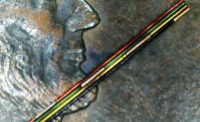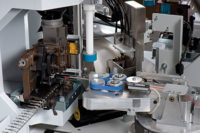Metal blades are typically used to strip insulation from wire or cable. However, there is an alternative—lasers. A precisely controlled laser beam can vaporize wire insulation and shielding with absolutely no chance of damaging the underlying electrical conductors.
The ongoing trend toward smaller wire diameters and more complex insulation structures is driving manufacturers to look beyond traditional wire stripping tools. Laser wire strippers offer a safe, reliable and productive alternative.
“Laser wire stripping produces a much greater yield than other methods and gives a much higher quality strip,” claims Rachael Pugh, marketing and communications manager at Spectrum Technologies PLC. “As wire and cable assemblies become smaller, more complex and more delicate, laser is often the only solution to avoid costly waste.”
Conventional wire stripping techniques include mechanical, abrasive, chemical and thermal methods. However, each has drawbacks, such as slow processing speed, a lack of precision, poor quality and potential conductor damage.
Mechanical wire strippers use sharpened steel blades to cut through and remove insulation. Although most systems offer fine blade adjustment and positive stops, damage to conductors, such as combed, pulled, scraped, cut, nicked or bird-caged strands, is inevitable.
With smaller wire gauges, it becomes more difficult to strip in a way that will not impair the conductive function of the wire. Twisted cables present a particular challenge to mechanical stripping systems, due to their noncircular cross sections.
Thermal stripping devices are expensive to operate, due to the high electrical consumption of the heater element. In addition, they are plagued with issues such as excessive edge flash, irregular transitions, and burned, melted or charred insulation. Thermal stripping can also leave dielectric residue, which can adversely affect electrical conductivity through the termination of the wire.
Chemical stripping is governed by strict regulations that control worker safety, air and water quality. The chemicals need to be handled carefully and disposed of as hazardous waste, which adds extra cost to the process.
A Practical Solution
Laser wire stripping offers a practical solution to both small diameter wires and nonround wire sections, due to the elimination of mechanical damage to the conductor and the capacity of the laser beam to tolerate irregular cross-sections.
Despite those advantages, laser wire stripping is still considered to be a niche application. “Mechanical will always be used in preference if it can, because of cost, but the number of applications is growing year by year,” notes Paul Taylor, CEO and managing director at Laser Wire Solutions.
“Many engineers are unaware of the possibilities,” Taylor points out. “But, those that do are designing cables with unique features that could not have been achieved without laser wire stripping. It will never be the primary stripping method for all cables, but the percentage of laser-stripped cables will increase steadily.”
A laser wire stripping system consists of a laser, an optical system, controls, application tooling and safety barriers. Engineers can choose between standalone automated machines, semiautomated benchtop units and manual handheld laser wire strippers. Single-axis, dual-axis and fixed-beam configurations are available, with power options ranging from 10 to 50 watts.
“Several types of lasers are available, including CO2, Nd:YAG and UV,” says Ken Deming, director of sales and marketing at Control Laser Corp. “However, CO2 is the most widely used and the most cost-effective.”
Deming’s company offers both benchtop and handheld units. “The latter fits in the palm of the user’s hand and can strip wire easier than mechanical hand strippers,” he claims. “It allows assemblers to process wires directly at a harness board.”
“Laser wire stripping uses a laser to cut around and down the length of insulating materials that cover the metal conductors of the wire,” adds Rick Stevenson, sales director at Control Micro Systems Inc., which originally developed its system for a major aerospace manufacturer. “This process allows the insulation to subsequently be pulled off very easily at a later time.
“Laser wire stripping is the most precise and reliable stripping method available today,” claims Stevenson. “By using the proper laser type for a particular wire, the insulation will absorb the beam and be vaporized. The metallic materials of the underlying wire conductor will reflect, like a mirror, the laser beam and will not be damaged.”
Diverse Applications
Laser wire stripping technology was developed in the mid-1970s by NASA engineers. Today, it’s primarily used by manufacturers in the aerospace and medical device industries. The process is also used to assemble micro coaxial cables that are widely used in personal electronic devices, such as laptops, notebooks and tablets.
Aerospace applications range from satellites to aircraft power leads. Dental drills, hearing aids, catheters, pacemakers, ultrasound transducers and other medical devices are also assembled using laser wire stripping equipment. Automotive applications include handbrake cables, air bag harnesses, and small motors and actuators.
“In some instances, the use of lasers has proved to be the only practical tool to use for wire stripping,” claims Laser Wire Solutions’s Taylor. “Lasers tend to be used where mechanical stripping is not an option.
“This can be because the wire is very thin, such as fine wires used in medical devices, and damage of the conductor during mechanical stripping leads to quality problems,” explains Taylor. “Other possibilities include applications where a cable has a cross section that’s difficult to strip mechanically, such as a jacketed twisted pair.”
Despite all those benefits, laser wire stripping is not widely used by manufacturers. “The technology is becoming more common, but cost [remains] the limiting factor,” says Spectrum Technologies’ Pugh
“We have seen a steady increase in the market over the last [decade], and this is evidenced by an increase in the number of new competitors,” explains Pugh. “We have also seen an increase in requests for more customized solutions and for highly complex cable constructions.”
Unfortunately, laser wire strippers are not widely affordable. “CO2 laser prices have not really decreased much over the last 10 years, so the price of a complete machine has not decreased either,” Pugh points out.
“Lasers are adopted where the parts are high value,” adds Taylor. “For penny type parts, you need very big volumes. So, applications are limited to those two areas—high value and low volume.
“The majority of engineers are not familiar with what can be achieved with laser stripping,” claims Taylor. “Cables are still designed and limited to what mechanical stripping can do. But, that is changing. As it does, lasers will become more common [in wire processing applications].”






